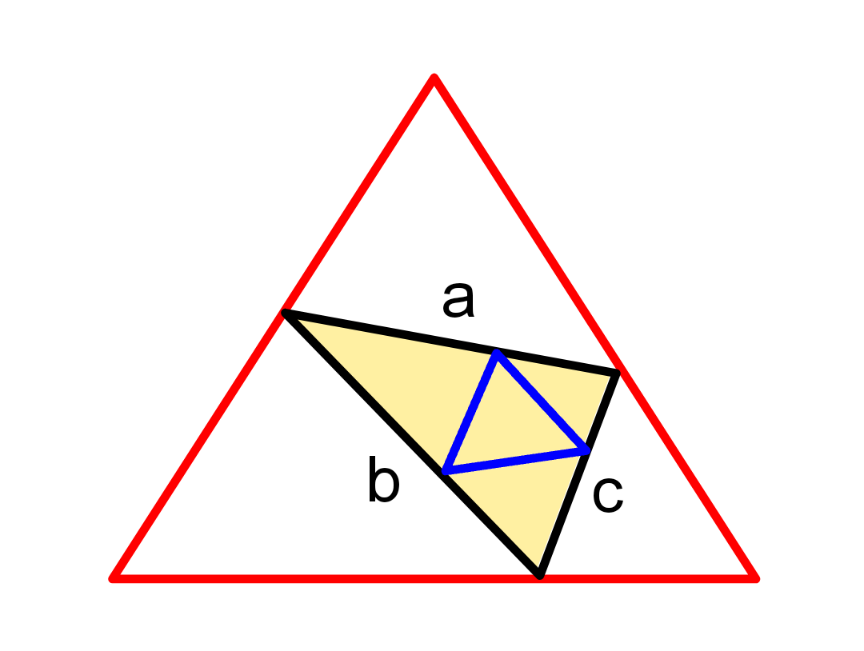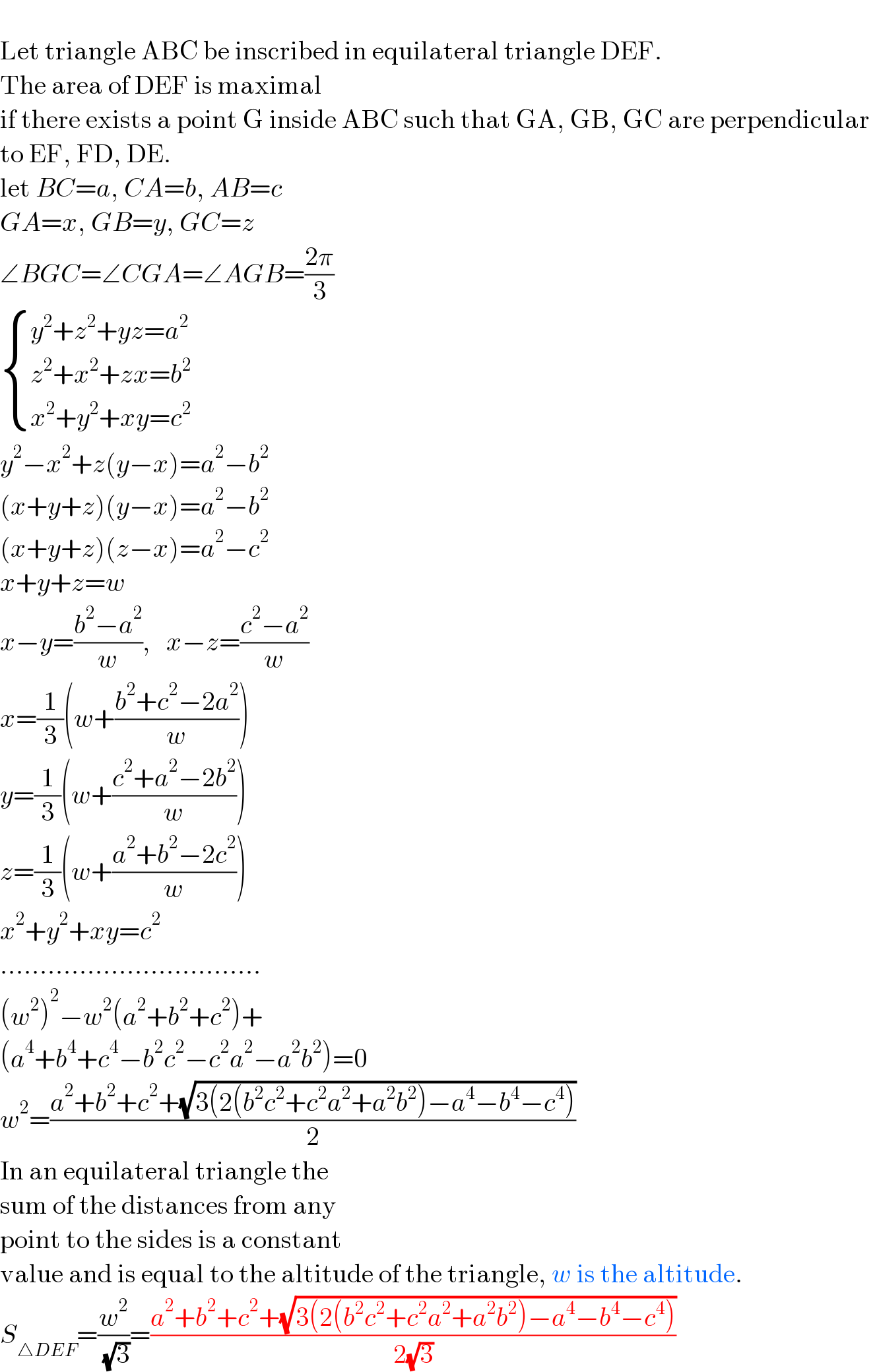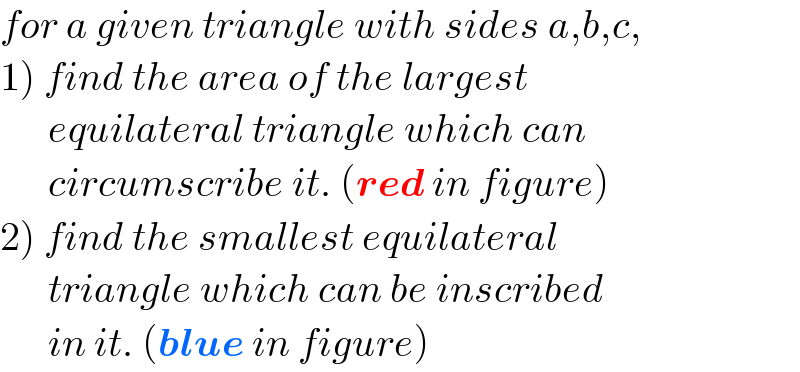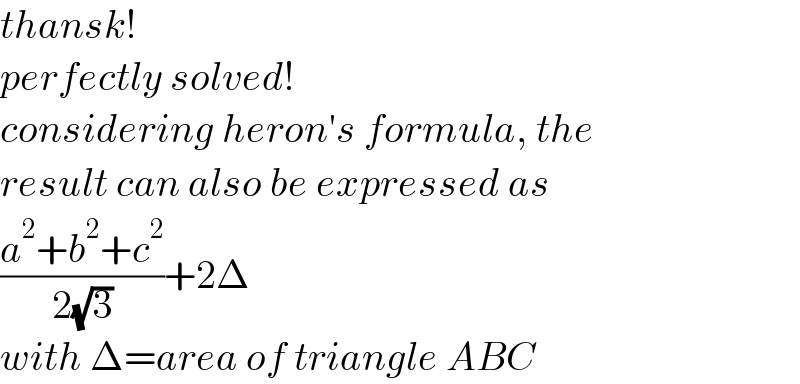
Question Number 218580 by mr W last updated on 12/Apr/25

Commented by vnm last updated on 12/Apr/25

$$ \\ $$$$\mathrm{Let}\:\mathrm{triangle}\:\mathrm{ABC}\:\mathrm{be}\:\mathrm{inscribed}\:\mathrm{in}\:\mathrm{equilateral}\:\mathrm{triangle}\:\mathrm{DEF}. \\ $$$$\mathrm{The}\:\mathrm{area}\:\mathrm{of}\:\mathrm{DEF}\:\mathrm{is}\:\mathrm{maximal}\: \\ $$$$\mathrm{if}\:\mathrm{there}\:\mathrm{exists}\:\mathrm{a}\:\mathrm{point}\:\mathrm{G}\:\mathrm{inside}\:\mathrm{ABC}\:\mathrm{such}\:\mathrm{that}\:\mathrm{GA},\:\mathrm{GB},\:\mathrm{GC}\:\mathrm{are}\:\mathrm{perpendicular}\: \\ $$$$\mathrm{to}\:\mathrm{EF},\:\mathrm{FD},\:\mathrm{DE}. \\ $$$$\mathrm{let}\:{BC}={a},\:{CA}={b},\:{AB}={c} \\ $$$${GA}={x},\:{GB}={y},\:{GC}={z} \\ $$$$\angle{BGC}=\angle{CGA}=\angle{AGB}=\frac{\mathrm{2}\pi}{\mathrm{3}} \\ $$$$\begin{cases}{{y}^{\mathrm{2}} +{z}^{\mathrm{2}} +{yz}={a}^{\mathrm{2}} }\\{{z}^{\mathrm{2}} +{x}^{\mathrm{2}} +{zx}={b}^{\mathrm{2}} }\\{{x}^{\mathrm{2}} +{y}^{\mathrm{2}} +{xy}={c}^{\mathrm{2}} }\end{cases} \\ $$$${y}^{\mathrm{2}} −{x}^{\mathrm{2}} +{z}\left({y}−{x}\right)={a}^{\mathrm{2}} −{b}^{\mathrm{2}} \\ $$$$\left({x}+{y}+{z}\right)\left({y}−{x}\right)={a}^{\mathrm{2}} −{b}^{\mathrm{2}} \\ $$$$\left({x}+{y}+{z}\right)\left({z}−{x}\right)={a}^{\mathrm{2}} −{c}^{\mathrm{2}} \\ $$$${x}+{y}+{z}={w} \\ $$$${x}−{y}=\frac{{b}^{\mathrm{2}} −{a}^{\mathrm{2}} }{{w}},\:\:\:{x}−{z}=\frac{{c}^{\mathrm{2}} −{a}^{\mathrm{2}} }{{w}} \\ $$$${x}=\frac{\mathrm{1}}{\mathrm{3}}\left({w}+\frac{{b}^{\mathrm{2}} +{c}^{\mathrm{2}} −\mathrm{2}{a}^{\mathrm{2}} }{{w}}\right) \\ $$$${y}=\frac{\mathrm{1}}{\mathrm{3}}\left({w}+\frac{{c}^{\mathrm{2}} +{a}^{\mathrm{2}} −\mathrm{2}{b}^{\mathrm{2}} }{{w}}\right) \\ $$$${z}=\frac{\mathrm{1}}{\mathrm{3}}\left({w}+\frac{{a}^{\mathrm{2}} +{b}^{\mathrm{2}} −\mathrm{2}{c}^{\mathrm{2}} }{{w}}\right) \\ $$$${x}^{\mathrm{2}} +{y}^{\mathrm{2}} +{xy}={c}^{\mathrm{2}} \\ $$$$................................. \\ $$$$\left({w}^{\mathrm{2}} \right)^{\mathrm{2}} −{w}^{\mathrm{2}} \left({a}^{\mathrm{2}} +{b}^{\mathrm{2}} +{c}^{\mathrm{2}} \right)+ \\ $$$$\left({a}^{\mathrm{4}} +{b}^{\mathrm{4}} +{c}^{\mathrm{4}} −{b}^{\mathrm{2}} {c}^{\mathrm{2}} −{c}^{\mathrm{2}} {a}^{\mathrm{2}} −{a}^{\mathrm{2}} {b}^{\mathrm{2}} \right)=\mathrm{0} \\ $$$${w}^{\mathrm{2}} =\frac{{a}^{\mathrm{2}} +{b}^{\mathrm{2}} +{c}^{\mathrm{2}} +\sqrt{\mathrm{3}\left(\mathrm{2}\left({b}^{\mathrm{2}} {c}^{\mathrm{2}} +{c}^{\mathrm{2}} {a}^{\mathrm{2}} +{a}^{\mathrm{2}} {b}^{\mathrm{2}} \right)−{a}^{\mathrm{4}} −{b}^{\mathrm{4}} −{c}^{\mathrm{4}} \right)}}{\mathrm{2}} \\ $$$$\mathrm{In}\:\mathrm{an}\:\mathrm{equilateral}\:\mathrm{triangle}\:\mathrm{the}\: \\ $$$$\mathrm{sum}\:\mathrm{of}\:\mathrm{the}\:\mathrm{distances}\:\mathrm{from}\:\mathrm{any} \\ $$$$\mathrm{point}\:\mathrm{to}\:\mathrm{the}\:\mathrm{sides}\:\mathrm{is}\:\mathrm{a}\:\mathrm{constant} \\ $$$$\mathrm{value}\:\mathrm{and}\:\mathrm{is}\:\mathrm{equal}\:\mathrm{to}\:\mathrm{the}\:\mathrm{altitude}\:\mathrm{of}\:\mathrm{the}\:\mathrm{triangle},\:{w}\:\mathrm{is}\:\mathrm{the}\:\mathrm{altitude}. \\ $$$${S}_{\bigtriangleup{DEF}} =\frac{{w}^{\mathrm{2}} }{\:\sqrt{\mathrm{3}}}=\frac{{a}^{\mathrm{2}} +{b}^{\mathrm{2}} +{c}^{\mathrm{2}} +\sqrt{\mathrm{3}\left(\mathrm{2}\left({b}^{\mathrm{2}} {c}^{\mathrm{2}} +{c}^{\mathrm{2}} {a}^{\mathrm{2}} +{a}^{\mathrm{2}} {b}^{\mathrm{2}} \right)−{a}^{\mathrm{4}} −{b}^{\mathrm{4}} −{c}^{\mathrm{4}} \right)}}{\mathrm{2}\sqrt{\mathrm{3}}} \\ $$
Commented by mr W last updated on 12/Apr/25

$${for}\:{a}\:{given}\:{triangle}\:{with}\:{sides}\:{a},{b},{c}, \\ $$$$\left.\mathrm{1}\right)\:{find}\:{the}\:{area}\:{of}\:{the}\:{largest}\: \\ $$$$\:\:\:\:\:\:{equilateral}\:{triangle}\:{which}\:{can}\: \\ $$$$\:\:\:\:\:\:{circumscribe}\:{it}.\:\left(\boldsymbol{{red}}\:{in}\:{figure}\right) \\ $$$$\left.\mathrm{2}\right)\:{find}\:{the}\:{smallest}\:{equilateral} \\ $$$$\:\:\:\:\:\:{triangle}\:{which}\:{can}\:{be}\:{inscribed} \\ $$$$\:\:\:\:\:\:{in}\:{it}.\:\left(\boldsymbol{{blue}}\:{in}\:{figure}\right) \\ $$
Commented by mr W last updated on 13/Apr/25

$${thansk}! \\ $$$${perfectly}\:{solved}! \\ $$$${considering}\:{heron}'{s}\:{formula},\:{the} \\ $$$${result}\:{can}\:{also}\:{be}\:{expressed}\:{as} \\ $$$$\frac{{a}^{\mathrm{2}} +{b}^{\mathrm{2}} +{c}^{\mathrm{2}} }{\mathrm{2}\sqrt{\mathrm{3}}}+\mathrm{2}\Delta \\ $$$${with}\:\Delta={area}\:{of}\:{triangle}\:{ABC} \\ $$
Answered by vnm last updated on 18/Apr/25

$$ \\ $$$${An}\:{algorithm}\:{for}\:{finding}\:{the} \\ $$$${area}\:{of}\:{the}\:{blue}\:{triangle}. \\ $$$${Triangle}\:{ABC}:\:{a}={BC},\:{b}={CA},\:{c}={AB} \\ $$$$\alpha=\mathrm{arccos}\frac{{b}^{\mathrm{2}} +{c}^{\mathrm{2}} −{a}^{\mathrm{2}} }{\mathrm{2}{bc}},\:\:\beta=\mathrm{arccos}\frac{{c}^{\mathrm{2}} +{a}^{\mathrm{2}} −{b}^{\mathrm{2}} }{\mathrm{2}{ca}},\:\:\gamma=\mathrm{arccos}\frac{{a}^{\mathrm{2}} +{b}^{\mathrm{2}} −{c}^{\mathrm{2}} }{\mathrm{2}{ab}} \\ $$$$\alpha_{\mathrm{1}} =\pi−\alpha,\:\:\beta_{\mathrm{1}} =\pi−\beta,\:\:\gamma_{\mathrm{1}} =\pi−\gamma \\ $$$${PQR}\:{is}\:{an}\:{equilateral}\:{triangle}\:{with}\:{side}\:{length}=\mathrm{1} \\ $$$${point}\:{M}\:{inside}\:{PQR},\:{such}\:{that} \\ $$$$\alpha_{\mathrm{1}} =\angle{QMR},\:\:\beta_{\mathrm{1}} =\angle{RMP},\:\:\gamma_{\mathrm{1}} =\angle{PMQ} \\ $$$${p}={MP},\:\:{q}={MQ},\:\:{r}={MR} \\ $$$$\varphi_{\alpha} =\angle{MQR}=\frac{\pi−\alpha_{\mathrm{1}} }{\mathrm{2}}−\delta,\:\:\theta_{\alpha} =\angle{MRQ}=\frac{\pi−\alpha_{\mathrm{1}} }{\mathrm{2}}+\delta \\ $$$$\frac{{r}}{\mathrm{sin}\varphi_{\alpha} }=\frac{\mathrm{1}}{\mathrm{sin}\alpha_{\mathrm{1}} }=\frac{{q}}{\mathrm{sin}\theta_{\alpha} } \\ $$$${q}=\frac{\mathrm{sin}\theta_{\alpha} }{\mathrm{sin}\alpha_{\mathrm{1}} },\:\:{r}=\frac{\mathrm{sin}\varphi_{\alpha} }{\mathrm{sin}\alpha_{\mathrm{1}} }{n} \\ $$$$\theta_{\gamma} =\angle{MQP}=\frac{\pi}{\mathrm{3}}−\varphi_{\alpha} = \\ $$$$\frac{\pi}{\mathrm{3}}−\left(\frac{\pi−\alpha_{\mathrm{1}} }{\mathrm{2}}−\delta\right)=\frac{\alpha_{\mathrm{1}} }{\mathrm{2}}−\frac{\pi}{\mathrm{6}}+\delta \\ $$$$\varphi_{\beta} =\angle{MRP}=\frac{\pi}{\mathrm{3}}−\theta_{\alpha} = \\ $$$$\frac{\pi}{\mathrm{3}}−\left(\frac{\pi−\alpha_{\mathrm{1}} }{\mathrm{2}}+\delta\right)=\frac{\alpha_{\mathrm{1}} }{\mathrm{2}}−\frac{\pi}{\mathrm{6}}−\delta \\ $$$$\frac{{p}}{\mathrm{sin}\theta_{\gamma} }=\frac{\mathrm{1}}{\mathrm{sin}\gamma_{\mathrm{1}} },\:\:{p}=\frac{\mathrm{sin}\theta_{\gamma} }{\mathrm{sin}\gamma_{\mathrm{1}} } \\ $$$$\frac{{p}}{\mathrm{sin}\varphi_{\beta} }=\frac{\mathrm{1}}{\mathrm{sin}\beta_{\mathrm{1}} },\:\:{p}=\frac{\mathrm{sin}\varphi_{\beta} }{\mathrm{sin}\beta_{\mathrm{1}} } \\ $$$$\frac{\mathrm{sin}\theta_{\gamma} }{\mathrm{sin}\gamma_{\mathrm{1}} }=\frac{\mathrm{sin}\varphi_{\beta} }{\mathrm{sin}\beta_{\mathrm{1}} },\:\:\mathrm{sin}\beta_{\mathrm{1}} \centerdot\mathrm{sin}\theta_{\gamma} =\mathrm{sin}\gamma_{\mathrm{1}} \centerdot\mathrm{sin}\varphi_{\beta} \\ $$$$\mathrm{sin}\beta_{\mathrm{1}} \centerdot\mathrm{sin}\left(\frac{\alpha_{\mathrm{1}} }{\mathrm{2}}−\frac{\pi}{\mathrm{6}}+\delta\right)=\mathrm{sin}\gamma_{\mathrm{1}} \centerdot\mathrm{sin}\left(\frac{\alpha_{\mathrm{1}} }{\mathrm{2}}−\frac{\pi}{\mathrm{6}}−\delta\right) \\ $$$$\mathrm{sin}\beta_{\mathrm{1}} \left(\mathrm{sin}\frac{\mathrm{3}\alpha_{\mathrm{1}} −\pi}{\mathrm{6}}\mathrm{cos}\delta+\mathrm{cos}\frac{\mathrm{3}\alpha_{\mathrm{1}} −\pi}{\mathrm{6}}\mathrm{sin}\delta\right)= \\ $$$$\mathrm{sin}\gamma_{\mathrm{1}} \left(\mathrm{sin}\frac{\mathrm{3}\alpha_{\mathrm{1}} −\pi}{\mathrm{6}}\mathrm{cos}\delta−\mathrm{cos}\frac{\mathrm{3}\alpha_{\mathrm{1}} −\pi}{\mathrm{6}}\mathrm{sin}\delta\right. \\ $$$$\left(\mathrm{sin}\gamma_{\mathrm{1}} −\mathrm{sin}\beta_{\mathrm{1}} \right)\mathrm{tan}\frac{\mathrm{3}\alpha_{\mathrm{1}} −\pi}{\mathrm{6}}=\left(\mathrm{sin}\gamma_{\mathrm{1}} +\mathrm{sin}\beta_{\mathrm{1}} \right)\mathrm{tan}\delta \\ $$$$\delta=\mathrm{arctan}\left(\frac{\mathrm{sin}\gamma_{\mathrm{1}} −\mathrm{sin}\beta_{\mathrm{1}} }{\mathrm{sin}\gamma_{\mathrm{1}} +\mathrm{sin}\beta_{\mathrm{1}} }\mathrm{tan}\frac{\mathrm{3}\alpha_{\mathrm{1}} −\pi}{\mathrm{6}}\right) \\ $$$${Now}\:{we}\:{can}\:{calculate}\:{p},\:{q},\:{r}. \\ $$$${Draw}\:{lines}\:{perpendicular}\:{toMP},\:{MQ},\:{MR}\: \\ $$$${through}\:{points}\:{P},\:{Q},\:{R}. \\ $$$${The}\:{points}\:{F},\:{G},\:{H}\:{where}\:{these} \\ $$$${lines}\:{intersect}\:{are}\:{the}\:{vertices}\: \\ $$$${of}\:{a}\:{triangle}\:{similar}\:{to}\:{triangle} \\ $$$${ABC}. \\ $$$${f}={GH}=\frac{\mathrm{1}}{\mathrm{2}}\left(\left({p}+{q}\right)\mathrm{tan}\frac{\gamma_{\mathrm{1}} }{\mathrm{2}}+\left({q}−{p}\right)\mathrm{cot}\frac{\gamma_{\mathrm{1}} }{\mathrm{2}}\right)+\frac{\mathrm{1}}{\mathrm{2}}\left(\left({p}+{r}\right)\mathrm{tan}\frac{\beta_{\mathrm{1}} }{\mathrm{2}}+\left({r}−{p}\right)\mathrm{cot}\frac{\beta_{\mathrm{1}} }{\mathrm{2}}\right) \\ $$$${g}={HF}=\frac{\mathrm{1}}{\mathrm{2}}\left(\left({q}+{r}\right)\mathrm{tan}\frac{\alpha_{\mathrm{1}} }{\mathrm{2}}+\left({r}−{q}\right)\mathrm{cot}\frac{\alpha_{\mathrm{1}} }{\mathrm{2}}\right)+\frac{\mathrm{1}}{\mathrm{2}}\left(\left({q}+{p}\right)\mathrm{tan}\frac{\gamma_{\mathrm{1}} }{\mathrm{2}}+\left({p}−{q}\right)\mathrm{cot}\frac{\gamma_{\mathrm{1}} }{\mathrm{2}}\right) \\ $$$${h}={FG}=\frac{\mathrm{1}}{\mathrm{2}}\left(\left({r}+{p}\right)\mathrm{tan}\frac{\beta_{\mathrm{1}} }{\mathrm{2}}+\left({p}−{r}\right)\mathrm{cot}\frac{\beta_{\mathrm{1}} }{\mathrm{2}}\right)+\frac{\mathrm{1}}{\mathrm{2}}\left(\left({r}+{q}\right)\mathrm{tan}\frac{\alpha_{\mathrm{1}} }{\mathrm{2}}+\left({q}−{r}\right)\mathrm{cot}\frac{\alpha_{\mathrm{1}} }{\mathrm{2}}\right) \\ $$$$\bigtriangleup{PQR}\:{is}\:{the}\:{minimal}\:{equilateral}\:{triangle}\:{inscribed}\:{in}\:\bigtriangleup{FGH}. \\ $$$${Answer}: \\ $$$${S}_{\bigtriangleup{min}.{equilat}} ={S}_{\bigtriangleup{ABC}} \frac{{S}_{\bigtriangleup{PQR}} }{{S}_{\bigtriangleup{FGH}} }=\frac{\sqrt{\mathrm{3}}{S}_{\bigtriangleup{ABC}} }{\mathrm{4}{S}_{\bigtriangleup{FGH}} } \\ $$$${for}\:{example} \\ $$$${a}=\mathrm{17},\:{b}=\mathrm{13},\:{c}=\mathrm{11} \\ $$$${S}_{\bigtriangleup{ABC}} =\mathrm{71}.\mathrm{4995629357271} \\ $$$$\mathrm{p}=\mathrm{0}.\mathrm{368961052327} \\ $$$${q}=\mathrm{0}.\mathrm{689772071985} \\ $$$${r}=\mathrm{0}.\mathrm{721618806573} \\ $$$$\mathrm{f}=\mathrm{2}.\mathrm{755346135575} \\ $$$${g}=\mathrm{2}.\mathrm{107029397793} \\ $$$${h}=\mathrm{1}.\mathrm{782871028902} \\ $$$$\frac{{f}}{{a}}=\frac{{g}}{{b}}=\frac{{h}}{{c}}=\mathrm{0}.\mathrm{162079184446} \\ $$$${S}_{\bigtriangleup{min}.{equilat}} =\mathrm{16}.\mathrm{483375438503} \\ $$
Commented by mr W last updated on 20/Apr/25

$${thanks}\:{sir}! \\ $$
